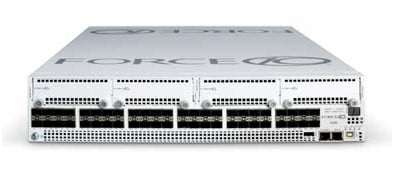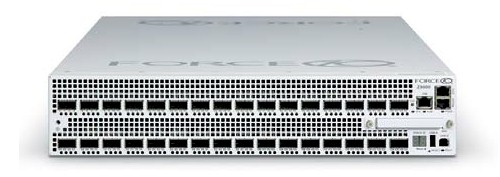Original URL: https://www.theregister.com/2011/04/26/force10_networks_switch_upgrade/
Force10 cranks Ethernet switches to 40 Gigabits
Will hit 100 Gigabits this year
Posted in Channel, 26th April 2011 15:26 GMT
The race to sell 40 Gigabit Ethernet switches for data center backbones and high-speed networks has begun, and Force10 Networks is getting out there early to stake its claims.
The company is announcing the Z9000 distributed core switch, which tops out at 40Gb/sec speeds but also supports a large number of 10Gb/sec ports if that's all you need at the moment. Force10 is also launching the S7000, a 10GE switch with 40GE uplinks for the top of server racks and is previewing the Z9512, a chassis core switch that will sport a large number of 10GE, 40GE, and 100GE ports. These switches are based on the Trident+ networking ASIC from Broadcom plus homegrown FPGAs that Force10 has cooked up to accelerate networking performance.
The S7000 switch, which will be available in the second half of 2011, is a fixed port switch with modular expansion ports – something that most switch-makers are doing these days on their more exotic top-of-rack machines. It has 1.28Tb/sec of line-rate bandwidth crammed into a 2U rack-mounted chassis. The S7000 supports 128,000 MAC addresses and up to 4,096 VLANs. It has a 9MB packet buffer to keep from choking on the L2 and L3 switching it does. The device also supports jumbo frames (important for networks hooking to big SMP servers), and supports user port stacking, virtual link trunking, and the Transparent Interconnection of Lots of Links (TRILL) standard for improving performance when packets have to make multiple hops in the network.

The Force10 S7000 top-of-racker
The S7000 has 36 ports that can run at Gigabit or 10GE speeds, plus another dozen ports that can be configured either as 10GE ports or Fibre Channel ports that rev at 1, 2, 4, or 8Gb/sec using the Fibre Channel over Ethernet (FCoE) portion of converged enhanced Ethernet. These ports support SFP or SFP+ cables. The S7000 switch also has four ports that run at 40GE speeds, which can be used as uplinks back to core switches or that can use breakout cables to convert each 40GE port to four 10GE ports; these ports use QSFP+ cables. In total, the S7000 could push and pull as many as 64 10GE ports. The S7000 has a peak power load of 800 watts and has redundant power supplies; it comes with AC or DC variants.
Like other switches these days, the S7000 from Force10 has application modules, based on x64 processors, that allow for applications that might otherwise run on appliances or on servers to be located inside of the switch itself. The S7000 has four such appliance modules, which slide into the top of the switch. Force10 and various partners will be adding applications to these modules, which will hook into Force10's FTOS switch operating system.
Arpit Joshipura, chief marketing officer at Force10, tells El Reg that the company is charging around $25,000 for the prior S4810 switch and expects to charge between $25,000 and $35,000 for the S7000, depending on the features installed.
The Z9000 distributed core switch has two Trident+ ASICs and sets of FPGAs and doubles up the aggregate port bandwidth up to 2.56Tb/sec. The distributed part of its name means that multiple Z9000s can be clustered together using leaf/spine configurations that deliver up to 160Tb/sec of distributed core bandwidth, according to Joshipura. With the Z9000, you can build line-rate, non-blocking leaf spine networks (also sometimes called CLOS architectures) that can support up to 2,000 server links running at 10GE speeds. If you match up the Z9000 core switches with a bunch of S4810 top-of-rackers and have a 3:1 over subscription, you can link to 6,000 servers using 10GE ports. Pushed to its limits, a network of Z9000 switches acting as a spine delivers 160Tb/sec of aggregate distributed core switch bandwidth and, using leaf switches and oversubscription, can support 24,000 server ports running at 10GE speeds or 160,000 servers running at Gigabit Ethernet speeds.

The Force10 Z9000 distributed core switch
"The leaf-spine concept is not new," admits Joshipura. "But no one has been able to do it at the scale, low power consumption, and low cost that we can now do."
Force10 says that if you need a core switch that has over 20Tb/sec of bandwidth, then you probably should move to a distributed core architecture to save yourself some dough. If you need somewhere between 5 and 20Tb/sec, then a more conventional core switch will probably do the trick.
The Z9000 comes in a 2U rack-mounted chassis and delivers 32 40GE ports or 128 10GE ports with a maximum power consumption of 800 watts. Joshipura says that the Z9000 will have one-tenth the footprint, use one-twentieth of the power, and cost one-fifth as much as comparable products from rival Cisco Systems. The Z9000 can support 128 SFP+ ports running at 10GE or 32 QSFP+ ports running at 40GE, depending on if you use the breakout cables or not. The base unit comes with the 40GE ports. The Z9000 switch supports 128,000 MAC addresses and 4,096 VLANs, just like the S7000, but has a 54MB packet buffer. The Z9000 supports standard routing protocols such as OSPF, BGP, and ECMP, and will inter-operate with Cisco and other switches at the fabric level if you want to do that. (This is what Force10 means when it says it has implemented "open cloud networking".)
The Z9000 distributed core switch will be available in July, with list prices starting at $175,000.
The third new switch that Force10 is talking about today is the Z9512. This is a modular core switch/router that comes in a 19U rack chassis that sports a dozen switch modules and delivers 16.8Tb/sec of aggregate switching bandwidth. The Z9512 will support 10-GE, 40GE, and 100GE speeds, with each module hosting 40 10GE, eight 40GE, or four 100GE line cards. That gives you 480 10GE, 96 40GE, or 48 100GE ports all running at line rate. And the bandwidth in the chassis, at 1Tb/sec per slot, will also allow for a lot more density than the initial release of the product, which is only allocating 400Gb/sec per line card slot in the first rev of the Z9512 switch/router. Force10 says its next-generation of line cards will be able to slide into the Z9512 chassis and presumably get their greedy ports on that extra bandwidth.
The Z9512 supports 1 million MAC addresses and 4,096 VLANs and has 8MB packet buffers per line card. The machine has redundant 3,000 watt AC power supplies and a DC option.
The Z9512 switch/router will be available in the second half of the year, with pricing depending on configuration. Joshipura says that the most similar Cisco modular switch runs around $6,500 per 10GE port, and that the Z9512 will probably cost on the order of $4,000 to $4,500 per 10GE port. ®